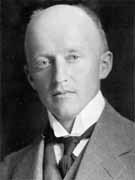Georg Faber
Quick Info
Kaiserslautern, Germany
Munich, Germany
Biography
Georg Faber studied mathematics and physics at the universities of Munich and Göttingen between 1896 and 1901. In 1902 he received a doctorate from the Ludwig-Maximilians University in Munich for a thesis Über Reihenentwicklungen analytischer Funktionen Ⓣ. He received his university teaching qualification from the University of Würzburg in 1905, after submitting his Habilitationsschrift presenting work on power series in several variables.He worked at a number of universities, being appointed to the University of Tübingen as an extraordinary professor in 1909, then a year later as an ordinary professor at the Technische Hochschule in Stuttgart. He remained in Stuttgart until 1912 when he moved to the University of Königsberg for a year, again moving on, this time to the University of Strasbourg. He was appointed to the chair of Higher Mathematics at the Technische Hochschule in Munich in 1916. This was a post he held until he retired in 1946.
Faber's most important work was on the polynomial expansion of functions. This is the problem of expanding an analytical function in an area bounded by a smooth curve as a sum of polynomials, where the polynomials are determined by the area. These polynomials are now known as 'Faber polynomials' and first appear in Faber's 1903 paper Über polynomische Entwickelungen Ⓣ published in Mathematische Annalen. Another important paper which he also published in Mathematische Annalen, this time in 1909, was Über stetige Funktionen Ⓣ. In this paper he introduced the 'hierarchical basis' and explicitly used it for the representation of functions. In fact Faber was building on the idea of Archimedes who computed approximately using a hierarchy of polygonal approximations of a circle. Only in the 1980s was Faber's idea seen to be an important ingredient for the efficient solution of partial differential equations.
Most of Faber's publications are in function theory. For example in addition to the papers mentioned above his publications include: Über die Fortsetzbarkeit gewisser Taylorscher Reihen Ⓣ (1903); Über arithmetische Eigenschaften analytischer Funktionen Ⓣ (1904); Über die Abzählbarkeit der rationalen Zahlen Ⓣ (1905); Über analytische Funktionen mit vorgeschriebenen Singularitäten Ⓣ (1905); Über die zusammengehörigen Konvergenzradien von Potenzreihen mehrerer Veränderlicher Ⓣ (1905); Über das Anwachsen analytischer Funktionen Ⓣ (1907); Beitrag zur Theorie der ganzen Funktionen Ⓣ (1910); and Über die interpolatorische Darstellung stetiger Funktionen Ⓣ (1914). However, he also edited the collected works of Christoffel and volumes 14, 15, and 16 of Euler's collected works.
One further achievement of Faber is worthy of mention. In 1894 Lord Rayleigh made the following claim:-
... given a fixed area of ox-hide to make a drum, the ground tone is lowest if you make your drum circular.Two mathematicians independently verified Rayleigh's conjecture, Faber and Edgar Krahn.
Faber was also interested in mathematical education and he worked with his colleague von Dyck at Munich on the mathematical education of engineers, physicists and mathematicians. In addition to his research areas, Faber lectured on complex analysis, probability theory, the theory of relativity and analytical mechanics.
When World War II ended in 1945, Faber was appointed rector of the Technische Hochschule in Munich by the government. He organised restarting teaching in the university, which happened in the spring of 1946, before retiring later that year. His achievements were marked by his election to the Bavarian Academy of Sciences in 1921, the award of the Order of Merit in 1956, and he received the Bavarian Service medal in 1959.
Faber had many interests outside mathematics. He was a great linguist enjoying the study of both classical and modern languages, he loved music and art, and he enjoyed long walks.
References (show)
- Georg Faber (1877-1966). Personalakte des Lehrkörpers, Eberhard Karls Universität Tübingen.
http://idb.ub.uni-tuebingen.de/opendigi/UAT_126_146 - Georg Faber (1877-1966), University of Manitoba.
https://www.math.umanitoba.ca/hat/people/faber.html - J Lense, Georg Faber 5.4.1877 - 7.3.1966, Bayerische Akademie der Wissenschaften.
https://badw.de/fileadmin/nachrufe/Faber%20Georg.pdf - B Maurer, Georg Faber (1877-1966)
http://www.kk.s.bw.schule.de/mathge/faber.htm
Additional Resources (show)
Other websites about Georg Faber:
Written by J J O'Connor and E F Robertson
Last Update August 2006
Last Update August 2006
